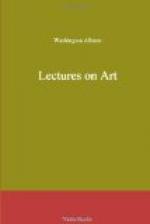But here it may be asked, How are we to distinguish an Idea from a mere notion? We answer, By its self-affirmation. For an ideal truth, having its own evidence in itself, can neither be proved nor disproved by any thing out of itself; whatever, then, impresses the mind as truth, is truth until it can be shown to be false; and consequently, in the converse, whatever can be brought into the sphere of the understanding, as a dialectic subject, is not an Idea. It will be observed, however, that we do not say an idea may not be denied; but to deny is not to disprove. Many things are denied in direct contradiction to fact; for the mind can command, and in no measured degree, the power of self-blinding, so that it cannot see what is actually before it. This is a psychological fact, which may be attested by thousands, who can well remember the time when they had once clearly discerned what has now vanished from their minds. Nor does the actual cessation of these primeval forms, or the after presence of their fragmentary, nay, disfigured relics, disprove their reality, or their original integrity, as we could not else call them up in their proper forms at any future time, to the reacknowledging their truth: a resuscitation and result, so to speak, which many have experienced.
In conclusion: though it be but one and the same Power that prescribes the form and determines the truth of all Ideas, there is yet an essential difference between the two classes of ideas to which we have referred; for it may well be doubted whether any Primary Idea can ever be fully realized by a finite mind,—at least in the present state. Take, for instance, the idea of beauty. In its highest form, as presented to the consciousness, we still find it referring to something beyond and above itself, as if it were but an approximation to a still higher form. The truth of this, we think, will be particularly felt by the artist, whether poet or painter, whose mind may be supposed, from his natural bias, to be more peculiarly capable of its highest developement; and what true artist was ever satisfied with any idea




